Chemical factories contribute to sustainability through various strategies and practices that aim to reduce environmental impact, improve resource efficiency, and promote long-term ecological balance. Here are some key ways in which are making strides towards sustainability:
1. Adopting Cleaner Production Methods
Chemical factories are increasingly implementing cleaner production techniques to minimize waste generation and pollutant emissions. This includes:
- Closed-loop systems: These systems recycle and reuse materials within the production process, reducing waste and the need for new raw materials.
- Process optimization: By optimizing reaction conditions and using more efficient catalysts, factories can reduce energy consumption and emissions.
2. Implementing Green Chemistry Principles
Green chemistry focuses on designing products and processes that minimize the use and generation of hazardous substances. Chemical factories are adopting these principles by:
- Using safer chemicals: Selecting less toxic and more environmentally friendly raw materials.
- Developing bio-based alternatives: Replacing traditional petrochemical feedstocks with renewable resources, such as bio-based materials.
3. Enhancing Energy Efficiency
Energy optimization is a crucial aspect of sustainability in chemical manufacturing. Factories are achieving this through:
- Energy-efficient equipment: Upgrading to machinery that consumes less electricity without compromising performance.
- Waste heat recovery: Capturing and reusing excess heat generated during production processes to reduce energy demand.
- Renewable energy sources: Integrating solar, wind, and other renewable energy sources to power factory operations, reducing reliance on fossil fuels.
4. Improving Waste Management
Effective waste management is essential for reducing the environmental footprint of chemical factories. Strategies include:
- Waste minimization: Implementing programs to reduce waste generation through recycling and reusing materials.
- Advanced wastewater treatment: Using technologies like membrane filtration and bioremediation to treat and purify wastewater before discharge.
- Solid waste management: Properly handling and disposing of byproducts and spent materials to prevent soil contamination.
5. Promoting Circular Economy Practices
The circular economy model aims to keep materials in use for as long as possible, reducing the need for new resources. Chemical factories are contributing by:
- Recycling and reusing materials: Implementing systems to recycle solvents, catalysts, and other materials within the production process.
- Product design for sustainability: Designing chemicals and products that have a longer lifespan and can be easily recycled.
6. Conducting Lifecycle Assessments
Lifecycle assessments help factories evaluate the environmental impacts of their products from raw material extraction to end-of-life disposal. This enables them to identify areas for improvement and prioritize sustainability efforts.
7. Collaboration and Regulation
Chemical factories are working closely with governments, academic institutions, and other stakeholders to drive sustainability initiatives. This includes:
- Regulatory compliance: Adhering to strict environmental regulations that control emissions, waste disposal, and resource use.
- Collaborative efforts: Partnering with other organizations to develop and implement best practices for sustainability.
Conclusion
Chemical factories are making significant contributions to sustainability by adopting cleaner production methods, implementing green chemistry principles, enhancing energy efficiency, improving waste management, and promoting circular economy practices. While challenges remain, ongoing technological advancements and collaborative efforts are driving the industry towards a more sustainable future.
